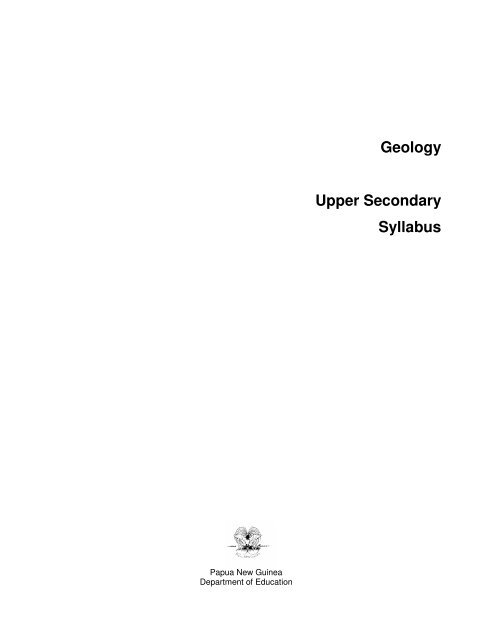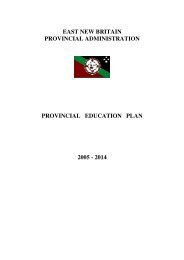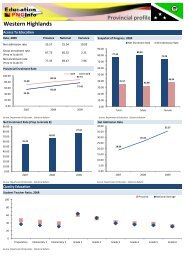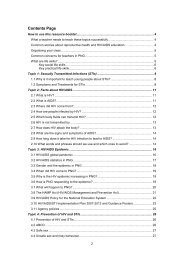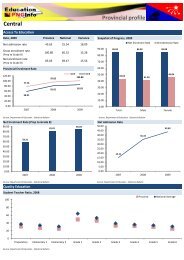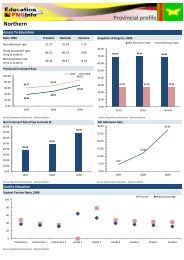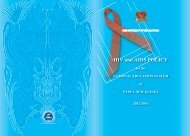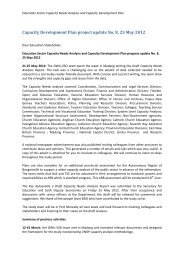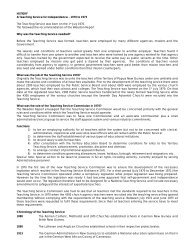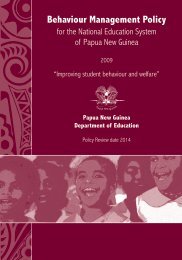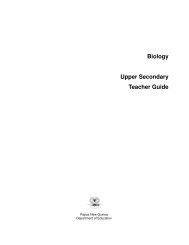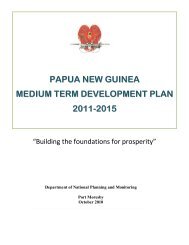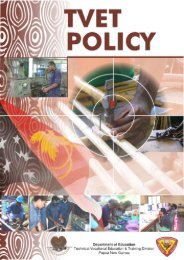Geology Upper Secondary Syllabus - Department of Education
Geology Upper Secondary Syllabus - Department of Education
Geology Upper Secondary Syllabus - Department of Education
Create successful ePaper yourself
Turn your PDF publications into a flip-book with our unique Google optimized e-Paper software.
<strong>Geology</strong><strong>Upper</strong> <strong>Secondary</strong><strong>Syllabus</strong>Papua New Guinea<strong>Department</strong> <strong>of</strong> <strong>Education</strong>
Issued free to schools by the <strong>Department</strong> <strong>of</strong> <strong>Education</strong>Published in 2008 by the <strong>Department</strong> <strong>of</strong> <strong>Education</strong>, Papua New Guinea© Copyright 2008, <strong>Department</strong> <strong>of</strong> <strong>Education</strong>, Papua New GuineaAll rights reserved. No part <strong>of</strong> this publication may be reproduced, stored in aretrieval system or transmitted by any form or by any means electronic,mechanical, photocopying, recording or otherwise without the prior writtenpermission <strong>of</strong> the publisher.ISBN 978-9980-9923-4-5AcknowledgementsThe <strong>Upper</strong> <strong>Secondary</strong> <strong>Geology</strong> <strong>Syllabus</strong> was written, edited and formattedby the Curriculum Development Division <strong>of</strong> the <strong>Department</strong> <strong>of</strong> <strong>Education</strong>.The development <strong>of</strong> the syllabus was coordinated by Pako Gau.Writers from schools, tertiary institutions and non-government organisationsacross the country have contributed to the writing <strong>of</strong> this syllabus throughspecialist writing workshops and consultations. Quality assurance groupsand the Science Advisory Committee have also contributed to thedevelopment <strong>of</strong> this syllabus.This document was developed with the support <strong>of</strong> the AustralianGovernment through the <strong>Education</strong> Capacity Building Program.
ContentsSecretary’s message ...................................................................... ivIntroduction......................................................................................1Rationale .........................................................................................3Aims ................................................................................................4Strands ............................................................................................5Learning outcomes ..........................................................................6Unit sequence and content ..............................................................7Grade 11 units .................................................................................8Grade 12 units ...............................................................................16Assessment components, weightings and tasks ............................26Assessment and certification .........................................................27
Secretary’s messageThis <strong>Geology</strong> syllabus is to be used by teachers <strong>of</strong> <strong>Geology</strong> to teach <strong>Upper</strong><strong>Secondary</strong> students (Grades 11 and 12) throughout Papua New Guinea.The syllabus builds on and enhances knowledge, skills and attitudes learntin Lower <strong>Secondary</strong>, and provides students with the opportunity to deepentheir understanding <strong>of</strong> advanced geological knowledge to meet individualneeds as well as local and global demands and challenges.Since <strong>Geology</strong> is a rapidly changing field, teachers <strong>of</strong> <strong>Geology</strong> play a pivotalrole by being innovative and creative, and by keeping abreast <strong>of</strong> newinformation that is based on scientific research and innovations intechnological change.Through the study <strong>of</strong> <strong>Geology</strong>, students consider the impact <strong>of</strong> humanactivities on ecosystems and the environment, as well as on individualhuman beings and human society, both in Papua New Guinea and globally.An understanding <strong>of</strong> <strong>Geology</strong>, and the application <strong>of</strong> this understanding, willhelp students to appreciate factors such as the culture, ethics, economics,power, and relationships that influence the pursuit <strong>of</strong> science, and have asignificant impact on the way people live.I commend and approve this syllabus as the <strong>of</strong>ficial curriculum for <strong>Geology</strong>to be used in all schools with Grades 11 and 12 students throughout PapuaNew Guinea.DR JOSEPH PAGELIOSecretary for <strong>Education</strong>
IntroductionThis syllabus is based on the curriculum principles from the NationalCurriculum Statement. It has been designed using learning outcomes thatidentify the knowledge, skills, attitudes and values that all students achieveor demonstrate by the end <strong>of</strong> Grade 12. It is linked to the national curriculumlearning area Science and builds on the knowledge and skills students havelearnt in Grades 9 and 10. This <strong>Geology</strong> syllabus <strong>of</strong>fers a number <strong>of</strong>pathways to post-secondary study and the workforce. It has specialised andgeneral applications in both areas.Lower <strong>Secondary</strong>ScienceStrandsLower <strong>Secondary</strong>ScienceUnits<strong>Upper</strong> <strong>Secondary</strong><strong>Geology</strong>Units4. Earth and space1. Nature <strong>of</strong> science3. Matter and energy• Strands 1 and 3 have somerelevance to <strong>Geology</strong> inrelation to the nature <strong>of</strong>the units, interdependenceand maintenance <strong>of</strong> naturalprocessesEarth andAtmosphereIntroduction to <strong>Geology</strong>Fossils and Geological AgeThe Dynamic Nature <strong>of</strong>the EarthContinental Drift and PlateTectonicsVolcanism and EarthquakesEarth’s ResourcesExploration and MiningEnvironmental Monitoringand ManagementOverview <strong>of</strong> the study <strong>of</strong> <strong>Geology</strong> from Lower <strong>Secondary</strong> to<strong>Upper</strong> <strong>Secondary</strong>Grade 9 ►Grade 10 ► Grade 11 ► Grade 129.7Earth andAtmosphere10.1WorkingScientificallythroughProjects andInvestigations11.1Introduction to<strong>Geology</strong>11.2Fossils andGeological Age12.1Volcanism and Earthquakes12.2Earth’s Resources11.3The DynamicNature <strong>of</strong> the Earth12.3Exploration and Mining11.4Continental Driftand Plate Tectonics12.4Environmental Monitoringand Management<strong>Geology</strong> is a specialised subject that requires a high level <strong>of</strong> cognitivecompetency, a high level <strong>of</strong> numeracy competency and a basic level <strong>of</strong>language skills.
<strong>Geology</strong>Assessment is an important component <strong>of</strong> teaching for learning and isintegrated into the learning and teaching activities <strong>of</strong> <strong>Geology</strong>. Continuousassessment in <strong>Geology</strong> provides feedback to students and the teacher onstudents’ progress towards achievement <strong>of</strong> the learning outcomes. It helpsstudents improve their standards <strong>of</strong> achievement by knowing what they needto do well and where they need to improve. In <strong>Geology</strong>, teachers will gatherevidence from students’ work during the course <strong>of</strong> the term and use thosecontinuous assessments to improve their teaching and students’ learning.The teaching program should also include formal summative assessment <strong>of</strong>learning to gauge students’ levels <strong>of</strong> achievement.<strong>Geology</strong> is to be timetabled for 240–250 minutes per week in Grade 11 andGrade 12.2
<strong>Upper</strong> <strong>Secondary</strong> <strong>Syllabus</strong>RationaleThe active land formation <strong>of</strong> Papua New Guinea indicates that the country isgeologically young. It is one <strong>of</strong> the most unstable regions in the world. Thegeological activities have led to the formation <strong>of</strong> natural resources such asminerals, oil and natural gas. While these natural resources are contributingto the development <strong>of</strong> Papua New Guinea, their extraction does have someimpacts on the lives <strong>of</strong> the people and the environment.Human beings have always had a great influence on the earth and theenvironment since they came into existence; and human beings must acceptresponsibility for their actions on earth. This is the context within whichscientifically literate geologists, including Papua New Guinean geologists,must demonstrate a sound understanding <strong>of</strong> geological principles, concepts,processes, systems and interactions, and make informed decisions.Students’ skills in problem solving, critical thinking and working cooperativelyin small groups are enhanced in the study <strong>of</strong> <strong>Geology</strong>. Acquiring these skillsenables students to explore various solutions to geological, environmentaland other related problems. Students develop values and attributes such asflexibility, curiosity, critical reflection and respect for evidence. These helpthem to consider issues and implications <strong>of</strong> having respect for theenvironment, both living and non-living. Students are able to recognise andunderstand the strengths and limitations <strong>of</strong> geological techniques andtechnologies in the field <strong>of</strong> geoscience.The geological knowledge and skills acquired through this course willprovide students with a foundation for sustainable living in their community,further education and the workforce.3
<strong>Geology</strong>Aims<strong>Geology</strong> aims to enable students to:• appreciate the processes that occur inside and outside the earth• appreciate the relationships between nature and humanity so that theycan be responsible for their actions• recognise the importance <strong>of</strong> sustaining earth resources for futuregenerations• appreciate the advantages and disadvantages <strong>of</strong> extracting earthresources• contribute meaningfully to the community in which they live, usingmodern and traditional practices• participate before, during and after natural disasters to reduce the impact<strong>of</strong> these disasters• educate their communities about the impact <strong>of</strong> natural geologicaldisasters and how to reduce the impact• provide advice on policies that affect the resource development in theircommunities• participate in and assist future developments, using past and presentgeological knowledge.4
<strong>Upper</strong> <strong>Secondary</strong> <strong>Syllabus</strong>StrandsThe study <strong>of</strong> <strong>Geology</strong> is described in the Lower <strong>Secondary</strong> Science strand‘Earth and space’.‘Earth and space’ discusses concepts <strong>of</strong> strata, natural process and cyclesand how the atmosphere interacts with the surface <strong>of</strong> the earth and itsimpact on the earth.Our lives depend on air, water and materials from the ground. The way welive depends on our landscape, weather and climate. This strand considers adiverse range <strong>of</strong> issues related to geology and the atmosphere. It providesan opportunity for students to explore the structure <strong>of</strong> the earth and naturalphenomena that bring about changes.This strand includes the various layers <strong>of</strong> the atmosphere and the importantroles they play. It looks at the nature and effect <strong>of</strong> rotations and revolutions<strong>of</strong> planets, including the earth. It also includes the active atmosphere, theeffects <strong>of</strong> radiation on land and water, and related issues.5
<strong>Geology</strong>Learning outcomesThe <strong>Geology</strong> learning outcomes identify the knowledge, skills, attitudes andvalues all students achieve or demonstrate at the end <strong>of</strong> Grade 12. Thelearning outcomes for <strong>Geology</strong> are listed below.Students can:1. demonstrate an understanding <strong>of</strong> fundamental concepts <strong>of</strong> geology2. design or use geological models to explain the interior and exterioractivities <strong>of</strong> the earth3. describe and explain the impact <strong>of</strong> geological events on the communityand the environment4. design and undertake investigations to solve geological problems inPapua New Guinea5. analyse, evaluate and interpret geological data and information6. communicate geological information in different ways7. demonstrate an understanding <strong>of</strong> traditional geological knowledge andpractices in their societies.Note: While all ideas and concepts in <strong>Geology</strong> are linked, the table belowindicates the connections that should be highlighted most.Learning outcomes mapped against unitsLearning outcomesUnits12.412.312.212.111.411.311.211.11. Demonstrate an understanding <strong>of</strong>fundamental concepts <strong>of</strong> geology2. Design or use geological models to explainthe interior and exterior activities <strong>of</strong> the earth3. Describe and explain the impact <strong>of</strong>geological events on the community and theenvironmenť ̌ ̌ ̌ ̌ ̌̌ ̌ ̌ ̌̌ ̌ ̌ ̌4. Design and undertake investigations to solvegeological problems in Papua New Guineǎ̌5. Analyse, evaluate and interpret geologicaldata and information6. Communicate geological information indifferent wayš ̌ ̌ ̌ ̌̌ ̌ ̌ ̌ ̌ ̌7. Demonstrate an understanding <strong>of</strong> traditionalgeological knowledge and practices in theirsocietieš̌6
<strong>Upper</strong> <strong>Secondary</strong> <strong>Syllabus</strong>Unit sequence and contentGrade 11 units11.1 Introduction to <strong>Geology</strong>9–10 weeks• What is <strong>Geology</strong>?• Structure and composition <strong>of</strong> the earth• Earth’s crust11.2 Fossils and Geological Age9–10 weeks• Geological timescale and its divisions• Features <strong>of</strong> different time divisions• Fossils• Fossils and interpretation <strong>of</strong> geologicalphenomena11.3 The Dynamic Nature <strong>of</strong> the Earth9–10 weeks• Major earth systems• Surficial processes11.4 Continental Drift and Plate Tectonics9–10 weeks• Theory <strong>of</strong> continental drift• Plate movements and collisionsGrade 12 units12.1 Volcanism and Earthquakes9–10 weeks• Volcanoes• Earthquakes12.2 Earth’s Resources9–10 weeks• Minerals and rocks• Oil and gas (fossil fuels)12.3 Exploration and Mining11–12 weeks• Exploration and prospecting• Extraction <strong>of</strong> minerals• Processing economic mineral resources• Refining economic mineral resources• Extraction <strong>of</strong> fossil fuels• Refining fossil fuels• Transportation <strong>of</strong> minerals, oil and gas• Case study <strong>of</strong> a mine in Papua NewGuinea• Management <strong>of</strong> mining activities12.4 Environmental Monitoring andManagement7–8 weeks• Risk strategies• Disaster management• Environmental impacts <strong>of</strong> mining7
<strong>Geology</strong>Grade 11 units11.1 Introduction to <strong>Geology</strong>9–10 weeksStudents understand that the earth has come through constant gradualchanges in its lifetime. They learn how and why the geomorphologic featuresthat are seen today are not the same as they were in the past and will not bethe same in the future. They appreciate the physical nature <strong>of</strong> the slowprocesses that shape the earth over time.This unit enables students to learn the basic geological concepts <strong>of</strong> theearth’s formation, structures, weathering processes and rock formation.Learning outcomesStudents can:1. demonstrate an understanding <strong>of</strong> fundamental concepts <strong>of</strong> geology5. analyse, evaluate and interpret geological data and information6. communicate geological information in different ways.To achieve these outcomes, students:• compare and contrast layers <strong>of</strong> the earth’s structure and theircomposition• compare and contrast rocks by appearance—degree <strong>of</strong> weathering• use models to explain earth structure and weathering processes• observe and investigate major rock types and classify them according totheir physical and chemical characteristics• communicate results <strong>of</strong> investigations and observationsContentStudents acquire knowledge and skills through the learning and teaching <strong>of</strong>this content.What is <strong>Geology</strong>?• definition• physical and chemical characteristics <strong>of</strong> rocks− elements and mineral makeup <strong>of</strong> rocksStructure and composition <strong>of</strong> the earth• structure <strong>of</strong> the earth• characteristics <strong>of</strong> the earth’s structure8
<strong>Upper</strong> <strong>Secondary</strong> <strong>Syllabus</strong>Earth’s crust• major rock types:− igneous− metamorphic− sedimentary• rock formation and cycles <strong>of</strong> the major rock types− physical and chemical weathering− erosionSkills, attitudes and valuesAttitudes and values• comprehension and appreciation <strong>of</strong> the geology <strong>of</strong> Papua New Guineaand the Pacific• being self-organising, reliable and responsibleProcess skills• observation and classification• map reading• interpretation <strong>of</strong> geological structuresGeneral skills• making decisions• thinking logically and critically• cooperating in groups• reading for understanding• communicating• solving problems9
<strong>Geology</strong>11.2 Fossils and Geological Age9–10 weeksIn this unit, students learn the divisions <strong>of</strong> the geological timescale—eras,periods and epochs—and the major fossil groups. They appreciate thegradual change <strong>of</strong> the earth’s processes and systems over time. Thedifferent fossil groups are discussed and then matched with the geologicaltimescale to show how fossils are used to determine geological age <strong>of</strong> rocks.Learning outcomesStudents can:1. demonstrate an understanding <strong>of</strong> fundamental concepts <strong>of</strong> geology2. design or use geological models to explain the interior and exterioractivities <strong>of</strong> the earth3. describe and explain the impact <strong>of</strong> geological events on the communityand the environment4. design and undertake investigations to solve geological problems inPapua New Guinea.To achieve these outcomes, students:• carry out library research and construct a geological timescale• study the main fossil groups, describe their formation and relative ages• relate the fossil age to the geological timescale• construct models to show formation <strong>of</strong> fossils• conduct laboratory activities on fossil dating <strong>of</strong> rock samples• visit a suitable site, investigate fossil-bearing rocks and determine therelative age <strong>of</strong> the rocks• investigate fossil-bearing rocks and correlate different stratigraphic units.ContentStudents acquire knowledge and skills through the learning and teaching <strong>of</strong>this content.Geological timescale and its divisions• era• period• epochFeatures <strong>of</strong> different time divisions• types <strong>of</strong> fauna and floraFossils• definition <strong>of</strong> a fossil10
<strong>Upper</strong> <strong>Secondary</strong> <strong>Syllabus</strong>• formation <strong>of</strong> fossils− conditions necessary for fossil formation− ways <strong>of</strong> fossil preservation• major fossil groupsFossils and interpretation <strong>of</strong> geological phenomena• using fossils to determine relative ages <strong>of</strong> rocks• fossils as indicators <strong>of</strong> the conditions <strong>of</strong> deposition• law <strong>of</strong> superposition• law <strong>of</strong> faunal assemblage− correlation <strong>of</strong> rocks and fossils in different placesSkills, attitudes and valuesAttitudes and values• comprehension and appreciation• being self-organising, reliable and responsible• being open-minded• being safety consciousProcess skills• data collection and organisation• rock correlation• stratigraphic correlation using fossils• scientific reportingGeneral skills• making decisions• thinking logically and critically• cooperating in groups• reading for understanding• communicating• solving problems11
<strong>Geology</strong>11.3 The Dynamic Nature <strong>of</strong> the Earth9–10 weeksStudents learn why the rivers continue to flow but never run out; and why theoceans receive water but never fill up. They understand how the mechanism<strong>of</strong> the atmosphere relating to other systems can affect the earth’s crust.This unit enables students to learn about major earth systems and surficialprocesses. These processes have geological importance on earth because<strong>of</strong> the ways in which they contribute to changing the earth’s crust.Learning outcomesStudents can:1. demonstrate an understanding <strong>of</strong> fundamental concepts <strong>of</strong> geology2. design or use geological models to explain the interior and exterioractivities <strong>of</strong> the earthTo achieve these outcomes, students can:• research and present findings on the earth’s systems• investigate and explain the effects <strong>of</strong> ground water• carry out measurement <strong>of</strong> river depth, width and speed, and observesediment sorting, grain size and sphericity• visit a nearby cave and observe evidence <strong>of</strong> limestone leaching and theformation <strong>of</strong> stalactites and stalagmites.ContentStudents acquire knowledge and skills through the learning and teaching <strong>of</strong>this content.Major earth systems• composition <strong>of</strong> the three major earth systems• atmosphere− nitrogen cycle− carbon cycle− water cycle• hydrosphere− oceans− surface water− ground water• lithosphere− section that includes the upper mantle12
<strong>Upper</strong> <strong>Secondary</strong> <strong>Syllabus</strong>Surficial processes• the water cycle• streams and sedimentation• ground water and its effects such as leaching• formation <strong>of</strong> limestone cavesSkills, attitudes and valuesAttitudes and values• comprehension and appreciation• being open-minded• being self-organising, reliable and responsible• being safety consciousProcess skills• hypothesising• observing• accurate recording <strong>of</strong> field data• interpretingGeneral skills• making decisions• thinking logically and critically• cooperating in groups• reading for understanding• communicating• solving problems• being imaginative, creative and innovative13
<strong>Geology</strong>11.4 Continental Drift and Plate Tectonics9–10 weeksThis unit enables students to learn about the theory <strong>of</strong> continental drift andthe different geological features that occur on the earth’s surface. Studentscompare and contrast the differences in the appearance <strong>of</strong> the crusts androcks at different locations <strong>of</strong> the earth. They understand the movement <strong>of</strong>the large land masses due to spreading <strong>of</strong> the ocean floor. The unit alsoexplains the disappearance <strong>of</strong> land masses through geological processessuch as subduction.Learning outcomesStudents can:1. demonstrate an understanding <strong>of</strong> fundamental concepts <strong>of</strong> geology2. design or use geological models to explain the interior and exterioractivities <strong>of</strong> the earth5. analyse, evaluate and interpret geological data and information6. communicate geological information in different ways.To achieve the learning outcomes, students:• carry out an activity on the shapes <strong>of</strong> continents• explain why rocks <strong>of</strong> similar properties or characteristics are found indifferent continents• investigate movement <strong>of</strong> continents through models• identify and interpret geological features on geological and world maps• construct and/or use models <strong>of</strong> plate boundaries and folding and faultingto explain the concepts• use analogies to explain the geology <strong>of</strong> the ocean floor• design models that demonstrate the activities <strong>of</strong> the ocean floor• conduct a field study <strong>of</strong> different folds and faults in a quarry or road cut orriver site or beach cut and discuss the sequence <strong>of</strong> geological events• carry out a field study <strong>of</strong> any geological feature in the environment andcommunicate their findings• use a geological map <strong>of</strong> Papua New Guinea and the Pacific to explainthe geological history.ContentStudents acquire knowledge and skills through the learning and teaching <strong>of</strong>this content.Theory <strong>of</strong> continental drift• Wegener’s theory− early clues− magnetic clues14
<strong>Upper</strong> <strong>Secondary</strong> <strong>Syllabus</strong>Plate movements and collisions• plate boundaries− world map <strong>of</strong> major plates− Papua New Guinea and the Pacific• movement <strong>of</strong> plates and collisions• major effects <strong>of</strong> movements <strong>of</strong> plates and collisions such as− earthquakes− tsunamis− volcanoes• mid-ocean ridges and spreading <strong>of</strong> sea floor• subduction and trenches• folds and faults− types <strong>of</strong> folds and faults− formation <strong>of</strong> mountains• overview <strong>of</strong> geology <strong>of</strong> Papua New Guinea such as:− geological map− formations− structures− rock types• geology <strong>of</strong> Papua New Guinea and the PacificSkills, attitudes and valuesAttitudes and values• comprehension and appreciation• being open-minded• being self-organising, reliable and responsible• being safety consciousProcess skills• observing• interpreting geological structures• reconstructing geological events• recording field data• field sketching• marking information on maps or aerial photographsGeneral skills• making decisions• thinking logically and critically• cooperating in groups• reading for understanding• communicating• solving problems15
<strong>Geology</strong>Grade 12 units12.1 Volcanism and Earthquakes9–10 weeksPapua New Guinea, being located on the ‘ring <strong>of</strong> fire’, is prone to naturaldisasters that are related to geological activities. The 1998 Aitape tsunami,and 1994 Rabaul and 2004 Manam volcanic eruptions, are all examples <strong>of</strong>natural disasters that severely disturbed the lives <strong>of</strong> the people, particularlypeople who lived close to the areas affected by these events. The 2005tsunami that swept through many parts <strong>of</strong> Asia and took thousands <strong>of</strong> livescan not be easily forgotten. The absence <strong>of</strong> early warning systems may havecontributed to the loss <strong>of</strong> many lives.This unit enables students to learn about the formation, structure and types<strong>of</strong> volcanoes. The distribution <strong>of</strong> volcanoes and their related geologicalactivities are discussed, as are earthquakes, seismic waves and theirintensities.This unit enables students to understand how tsunami, volcanoes andearthquakes are caused. Students outline measures that need to beundertaken by people before disaster strikes. Students or a community eldercan also share experiences <strong>of</strong> their traditional practices <strong>of</strong> early warningmethods. Students also do research on the modern early warning systemsthat exist in various parts <strong>of</strong> the world and propose where these could bestrategically located in Papua New Guinea.Learning outcomesStudents can:1. demonstrate an understanding <strong>of</strong> fundamental concepts <strong>of</strong> geology2. design or use geological models to explain the interior and exterioractivities <strong>of</strong> the earth3. describe and explain the impact <strong>of</strong> geological events on the communityand the environment5. analyse, evaluate and interpret geological data and information6. communicate geological information in different ways7. demonstrate an understanding <strong>of</strong> traditional geological knowledge andpractices in their societies.To achieve the learning outcomes, students:• describe how tsunami, volcanoes and earthquakes are caused• construct and/or use models <strong>of</strong> volcanoes to demonstrate how they erupt• use geological and world maps to interpret geological features• use geological data to interpret intensity <strong>of</strong> earthquakes• determine the focus and epicentre <strong>of</strong> earthquakes through calculation <strong>of</strong>available data• develop a case study <strong>of</strong> an area affected by volcanic eruptions orearthquakes16
<strong>Upper</strong> <strong>Secondary</strong> <strong>Syllabus</strong>• discuss, write and report on traditional knowledge and practices <strong>of</strong>predicting natural disasters related to geological activities.• explain strategic measures to deal with the effects <strong>of</strong> disasters• visit a geological feature related to volcanoes or earthquakes and explainhow it formed.ContentStudents acquire knowledge and skills through the learning and teaching <strong>of</strong>this content.Volcanoes• formation <strong>of</strong> volcanoes• structure <strong>of</strong> volcanoes• types <strong>of</strong> volcanoes• distribution <strong>of</strong> volcanoes worldwide• signs and warnings <strong>of</strong> an erupting volcano• volcanic activities and ejecta• effects <strong>of</strong> volcanoes such as− land formations− lava flows− ravines and crevasses• effects on communities and environments• traditional knowledge and practices <strong>of</strong> volcanic activities• effects <strong>of</strong> volcanic activity in Papua New Guinea such as Rabaul,Madang, Kimbe and so onEarthquakes• earthquakes• wave types and epicentre• strength <strong>of</strong> the earthquakes− measurement <strong>of</strong> earth movements− seismograph− the Richter scale• geological effects <strong>of</strong> earthquakes such as− subsidence− uplift− landslides− tsunamis− ravines and crevasses• effects on communities and environments• traditional knowledge and practices <strong>of</strong> earthquake activities• effects <strong>of</strong> earthquake activity in Papua New Guinea such as Aitape andRabaul.17
<strong>Geology</strong>Skills, attitudes and valuesAttitudes and values• comprehension and appreciation• being open-minded• being self-organising, reliable and responsible• being safety consciousProcess skills• observing• analysing• interpreting geological structures and features• recording field findings• field sketchingGeneral skills• making decisions• thinking logically and critically• cooperating in groups• reading for understanding• communicating• solving problems18
<strong>Upper</strong> <strong>Secondary</strong> <strong>Syllabus</strong>12.2 Earth’s Resources9–10 weeksResources such as oil, gas and minerals are very important. Papua NewGuinea is rich in natural resources such as minerals, oil and gas. While ittakes a very long time for these resources to be formed, the rates <strong>of</strong>extraction and depletion <strong>of</strong> these resources are very fast. The unit enablesstudents to identify the different types <strong>of</strong> earth resources and explain howthese are formed and used.Learning outcomesStudents can:1. demonstrate an understanding <strong>of</strong> fundamental concepts <strong>of</strong> geology5. analyse, evaluate and interpret geological data and information6. communicate geological information in different waysTo achieve the learning outcomes, students:• interpret geological maps to determine locations <strong>of</strong> minerals• use samples and charts <strong>of</strong> minerals to identify mineral types• use simple tests to identify mineral types• explain how earth’s resources were formed• demonstrate understanding <strong>of</strong> the importance and uses <strong>of</strong> resourcesContentStudents acquire knowledge and skills through the learning and teaching <strong>of</strong>this content.Minerals and rocks• minerals <strong>of</strong> economic importance such as− gold, silver, lead, copper, nickel, zinc and so on• location <strong>of</strong> minerals in Papua New Guinea• simple model <strong>of</strong> mineral formation• examples <strong>of</strong> mineral ores such as bauxite (aluminium), azurite, malachite(copper), galena (lead)• uses <strong>of</strong> minerals and rocks• simple tests to identify mineralsOil and gas (fossil fuels)• formation <strong>of</strong> crude oil and gas• characteristics <strong>of</strong> crude oil• characteristics <strong>of</strong> natural gas• location <strong>of</strong> major oil and gas fields in the world19
<strong>Geology</strong>− location <strong>of</strong> oil and gas fields in Papua New Guinea• importance <strong>of</strong> crude oil and gas• uses <strong>of</strong> crude oil and gas.SkillsAttitudes and values• comprehension and appreciation• being open-minded• being self-organising, reliable and responsible• being safety consciousProcess skills• classifying• analysis and synthesis <strong>of</strong> geological information• interpreting geological data• interpreting geological mapsGeneral skills• making decisions• thinking logically and critically• cooperating in groups• reading for understanding• communicating• solving problems20
<strong>Upper</strong> <strong>Secondary</strong> <strong>Syllabus</strong>12.3 Exploration and Mining11–12 weeksProspecting for mineral ores and exploration for oil and gas are the firststeps to harnessing earth resources. Mining and processing are the nextsteps. This unit enables students to understand the processes involved inprospecting, exploration, mining and processing. Natural resources are notnormally ready to be used straight from the ground. Ore minerals, crude oiland natural gas are processed before they can be used.Students understand the roles <strong>of</strong> government, resource developer andresource owner in resource development. We need policies to guide us inusing these resources so they sustain our livelihood in a global marketeconomy, and to reduce environmental impacts on our societies.Learning outcomesStudents can:3. describe and explain the impact <strong>of</strong> geological events on the communityand the environment4. design and undertake investigations to solve geological problems inPapua New Guinea5. analyse, evaluate and interpret geological data and information6. communicate geological information in different ways.To achieve these learning outcomes, students:• describe the methods involved in prospecting, exploration, mining andrefining• state the different types <strong>of</strong> exploration and mining activities• evaluate an existing agreement between various stakeholders involvedin resource development and apply it to their context• discuss some landowner issues relating to exploration and miningactivities• list some environmental issues relating to mining activities• describe how earth resources are extracted and processed for use• review existing resource management policies, provide a critique from aresource owner’s viewpoint and <strong>of</strong>fer alternatives• visit a sea or land or forest habitat and study the impacts <strong>of</strong> miningactivities.ContentStudents acquire knowledge and skills through the learning and teaching <strong>of</strong>this content.Exploration and prospecting• historical methods21
<strong>Geology</strong>− prospecting− examples <strong>of</strong> discoveries in Papua New Guinea• methods <strong>of</strong> exploration− surface observation− geochemical and geophysical methods− remote sensing• licensing <strong>of</strong> prospectors• location <strong>of</strong> mine sites in Papua New GuineaExtraction <strong>of</strong> minerals• types <strong>of</strong> mines such as− open cut (copper, gold, limestone)− underground (gold)− underwater (copper, lead, gold)− alluvial (gold)Processing economic mineral resources• crushing• washing• concentrating such as gravity and floatationRefining economic mineral resources• smelting• electrolysisExtraction <strong>of</strong> fossil fuels• oil drilling− <strong>of</strong>fshore− onshore• gas extractionRefining fossil fuels• distillation• fractional distillationTransportation <strong>of</strong> minerals, oil and gas• Feasible, safe ways to transport materials such as− slurry in pipes− concentrate− oil tankers− oil pipelines− gas tankers or pipelines for liquefied petroleum gas (LPG)22
<strong>Upper</strong> <strong>Secondary</strong> <strong>Syllabus</strong>Case study <strong>of</strong> a mine in Papua New Guinea• location• how and when minerals discovered• type <strong>of</strong> minerals and extraction methods used• environmental impact• importance <strong>of</strong> the mine to Papua New GuineaManagement <strong>of</strong> mining activities• policies on managing resourcesSkills, attitudes and valuesAttitudes and values• comprehension and appreciation• being open-minded• being self-organising, reliable and responsible• being safety consciousProcess skills• observing• recording <strong>of</strong> geological data• analysis and synthesis• interpretationGeneral skills• making decisions• thinking logically and critically• cooperating in groups• reading for understanding• communicating• solving problems23
<strong>Geology</strong>12.4 Environmental Monitoring and Management7–8 weeksIn this unit, students understand the relationship between human beings andthe environment and how it should remain cordial to reduce risks <strong>of</strong> naturaldisasters. Students formulate strategies for monitoring and managing risksto reduce loss <strong>of</strong> property and lives. Students devise management structuresand list resources for managing the aftermath <strong>of</strong> a natural disaster or effects<strong>of</strong> human activities on the environment.Learning outcomesStudents can:3. describe and explain the impact <strong>of</strong> geological events on the communityand the environment6. communicate geological information in different ways7. demonstrate an understanding <strong>of</strong> traditional geological knowledge andpractices in their societies.To achieve these outcomes, students:• identify risk strategies for specific natural disasters• devise a management structure for managing the aftermath <strong>of</strong> disaster• describe the traditional practices for risk strategies and management• put in place a simple evacuation plan for a geological disaster.ContentStudents acquire knowledge and skills through the learning and teaching <strong>of</strong>this content.Risk strategies• disaster committee• early warning systems• awareness• evacuation measures• suitable management structuresDisaster management• counselling• relief supplies• finance <strong>of</strong> services• restoration• traditional management practices24
<strong>Upper</strong> <strong>Secondary</strong> <strong>Syllabus</strong>Environmental impacts <strong>of</strong> mining• destruction <strong>of</strong> habitats, land and sea• pollution− air− water− soil• policies on environmental management <strong>of</strong> mining activities− environmental impact studies− responsibility for impacts <strong>of</strong> mines− restoring the environment after the closure <strong>of</strong> minesSkills, attitudes and valuesAttitudes and values• comprehension and appreciation• being open-minded• being self-organising, reliable and responsible• being safety consciousProcess skills• observing• interpreting data• reconstructing geological events• recording field data• marking information on a disaster map• planning, management and reportingGeneral skills• making decisions• thinking logically and critically• cooperating in groups• reading for understanding• communicating• solving problems25
<strong>Geology</strong>Assessment components, weightings and tasksThe internal assessment mark for <strong>Geology</strong> is to be based on the Grades 11and 12 syllabus only. Final assessment should be based on a range andbalance <strong>of</strong> assessment instruments. One task may be used to assessseveral components. The components, weightings and tasks for Grades 11and 12 units are detailed below.Components, weighting and tasks for Grade 11Component Weighting TasksWritten tests 150 These may include multiple-choice items, short answersand extended responses, data interpretation, graphicalskills, calculationsPractical tests on basicskills50 Testing the ability <strong>of</strong> students doing simple geological labtests and presentation <strong>of</strong> reportsDoing simple research reports and presentationSimple calculationsPractical investigativeskills100 Practical work competency and some ratings given onpresentation and communicationMarks 300Components, weighting and tasks for Grade 12Component Weighting TasksWritten tests 150 These may include multiple-choice items, short answers,essays and extended responsesStatistical interpretation, graphical skills, calculationsPractical tests on basicskills50 Testing the ability <strong>of</strong> students doing simple <strong>Geology</strong>techniques such as observation, interpretation, analysingresults and writing conclusionsPractical investigativeskills100 Practical work competency and some ratings given onpresentation and communication based appropriateresearch methodologiesMarks 30026
<strong>Upper</strong> <strong>Secondary</strong> <strong>Syllabus</strong>Assessment and certificationAssessment and reporting practices described here are detailed further inthe National Assessment and Reporting Policy for Papua New Guinea(2003) and in other support materials produced by the <strong>Department</strong> <strong>of</strong><strong>Education</strong>.AssessmentThe main purpose <strong>of</strong> assessment is to improve student learning.Assessment needs to be for learning as well as <strong>of</strong> learning. It is used toevaluate and improve learning and teaching, report achievement andprovide feedback to students on their progress.Assessment measures students’ achievement <strong>of</strong> learning outcomes asdescribed in the syllabus. It is the ongoing process <strong>of</strong> identifying, gatheringand interpreting information about students’ achievement <strong>of</strong> the learningoutcomes.Teaching and learning using an outcomes approach requires teachers toplan their teaching and assess learner performance in relation to outcomes,using criteria derived from those outcomes. Assessment involves focusingless on whether a learner has ‘passed’ or ‘failed’ and more on whatoutcomes a learner has achieved and in which areas further support isrequired.Assessment in <strong>Geology</strong>A student’s achievement in <strong>Geology</strong> at the end <strong>of</strong> Grade 12 will be assessedagainst the learning outcomes. Assessment <strong>of</strong> student progress towardsachieving these learning outcomes is cumulative throughout Grades 11and 12.It is important that teachers plan the learning and teaching sequence so thatthere is a balanced spread <strong>of</strong> assessment during the year. Some tasks, suchas investigations or case studies, can be designed so that they arecompleted over a period <strong>of</strong> time rather than at the end <strong>of</strong> the unit. Othertasks can be done immediately the relevant section <strong>of</strong> the unit or topic hasbeen covered.Assessment for certificationA student’s overall achievement in <strong>Geology</strong> will be both internally andexternally assessed. The final mark awarded to each student will be acombination <strong>of</strong> the internal assessment mark provided by the school and theexamination mark.Internal assessmentInternal assessment provides a measure <strong>of</strong> a student’s achievement basedon a wider range <strong>of</strong> syllabus content and outcomes than may be covered bythe external examination alone. For <strong>Geology</strong> the internal assessment marks27
<strong>Geology</strong>will provide a summation <strong>of</strong> each student’s achievements in Grades 11and 12. The assessment tasks used to determine the internal assessmentmark must comply with the components, weightings and types <strong>of</strong> tasksspecified in the tables on page 26. A variety <strong>of</strong> tasks gives students theopportunity to demonstrate all the learning outcomes in different ways toimprove the validity and reliability <strong>of</strong> the assessment.All schools must meet the requirements for internal assessment as specifiedin the Grade 12 Assessment, Examination and Certification Handbook.RecordingAll schools must meet the requirements for maintaining and submittingstudent records as specified in the Grade 12 Assessment, Examination andCertification Handbook.CertificationCandidates will be awarded the national certificate only if they meet allrequirements for internal and external assessment. Eligibility rules for theaward <strong>of</strong> certificates are specified in the Grade 12 Assessment, Examinationand Certification Handbook.28


